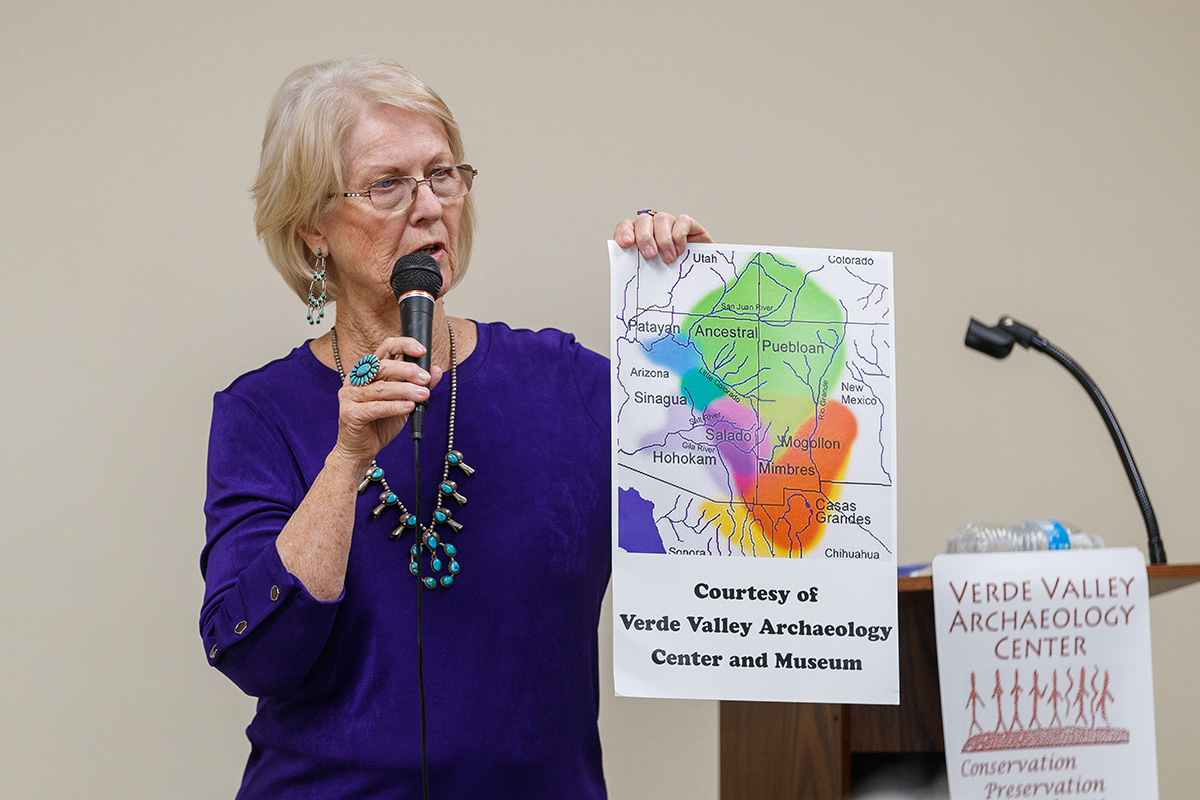
Author Charmayne Samuelson discussed her book “Spencer MacCallum: Memories, Mystique, Mata Ortiz” at the Verde Valley Archaeology Center on Saturday, Dec. 9.
Her biography of MacCallum chronicled his journeys as an anthropologist and his fascination with and study of Mata Ortiz pottery and Juan Quezada, a potter who created the Mata Ortiz style.
Mata Ortiz pottery is a modern recreation of the pottery found in and around Casas Grandes, a 12th-century Mogollon culture archaeological site in Mexico. The ruins make up a large structure with over 2,000 rooms.
The pottery style is named after the nearby town of Mata Ortiz. The movement was led by Juan Quezada, a self-taught potter, who recreated the ancient pottery found there and ultimately created his own unique style based on the older artifacts. MacCallum discovered Quezada and funded his work, eventually sharing Mata Ortiz pottery with the rest of the world.
Samuelson first met MacCallum when she and her husband were working as trip leaders for guided tours to Mexico. MacCallum gave presentations to their tour groups and they befriended one another. While Quezada and his pottery were in the spotlight, Samuelson noticed that little attention was paid to MacCallum, without whom the pottery would be virtually unknown. She suggested someone should write his biography, and he in turn told her that she should write it. They spent time conducting a series of interviews at Samuelson’s home in Sierra Vista for several years, and the completed book was released in July.
MacCallum’s father was an architect and his grandfather, Spencer Heath, founded the American Propeller Manufacturing Company that produced aircraft propellers under the brand name Paragon and furnished three quarters of the aircraft propellers used by the Allies during World War I.
After World War II MacCallum’s mother wanted her children to be exposed to another culture, believing that power now lay between the U.S. and Mexico, and drove the family from Virginia to Mexico. They lived there for two years and MacCallum became interested in archaeology, frequented the ruins and hung out with archaeologists in the field.
In 1954, MacCallum received a bachelor’s degree in anthropology from Princeton and later received his master’s degree in anthropology from the University of Washington. He later enrolled in a doctoral program at Princeton but had a nervous breakdown and was unable to function in society for almost a decade. During that period, he started writing and publishing some of his grandfather’s works. He also discovered his love for garage sales and junk shops, enjoying the ability to find unique items. This would eventually lead him to Mata Ortiz pottery.
In 1976, when MacCallum invested in a gold mine in Deming, New Mexico, he wandered into Bob’s Swap Shop in Deming and saw three pots, believing them to be pre-Columbian. The shop owner told him that they were intentionally distressed by the artist to look old in order to be sold to tourists. MacCallum, unconvinced, purchased the pots.
He soon went to Mexico and brought photographs of the pots with him, asking people along the way about who might have made the vessels. He ended up in the town of Mata Ortiz and was directed to the home of Juan Quezada.
Quezada was the creator of MacCallum’s “prehistoric” pots and had many more in his house, and MacCallum asked if he could make even better ones. When MacCallum returned a month later, Quezada only had the same items on display; once Quezada knew he was serious, he provided MacCallum with his best work. MacCallum began paying him $300 a month for his pottery, which Samuelson said was the equivalent of around $2,000 in today’s terms.
MacCallum later witnessed a new style of pottery that Quezada had been working on. Now called Mata Ortiz pottery, Quezada and his family taught many other people this style of pottery. MacCallum helped set up showings at museums and pottery demonstrations, sharing this modern interpretation of ancient pottery with the world.
The lecture was followed by a book signing and a Mata Ortiz pottery trunk show.